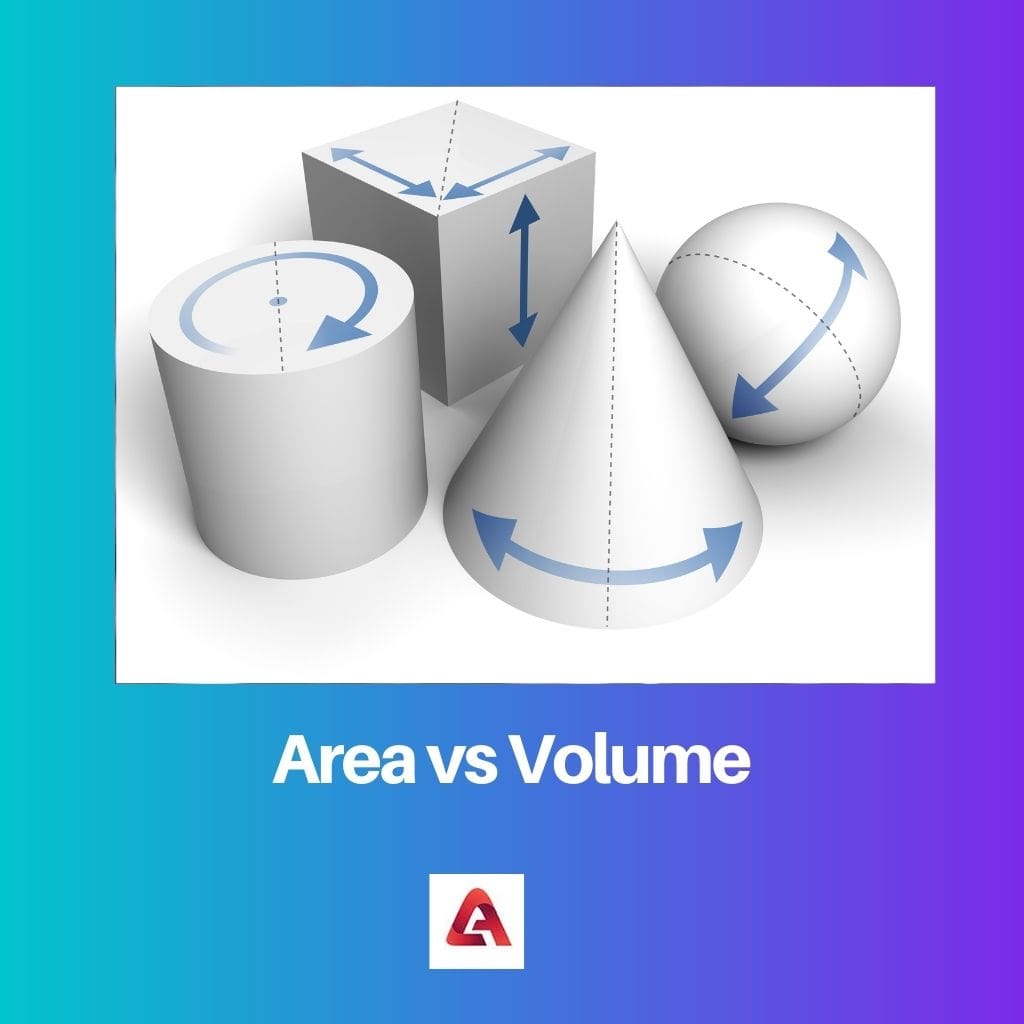Area refers to the measure of the two-dimensional space covered by a surface, while volume pertains to the measure of the three-dimensional space occupied by a solid object.
Key Takeaways
- The area measures the extent of a two-dimensional surface, such as the size of a piece of land or the surface of an object.
- Volume quantifies the amount of space a three-dimensional object occupies, like the capacity of a container or the size of a solid figure.
- Understanding the distinction between area and volume is essential in various fields, including geometry, engineering, and real estate.
Area vs Volume
The Area refers to the region covered by the object, while volume refers to the quantity or capacity of the object. An area is two-dimensional object and covers the outer space, Volume is a three-dimensional object and covers the inner capacity. The Area is a plain figure; Volume is a solid figure.

The total space that objects occupy when placed on a plane or flat surface is known as the area of the object. Similarly, there are also some objects that have their own capacity.
For example, a water tank has its own capacity to hold a certain amount of water inside.
This capacity is the volume of the water tank. You must note that only hollow objects have volumes that can be measured with relevant formulae.
The table and forthcoming information on the two terms should illuminate the topic and help you understand the basic differences between an area and the volume of an object.
Comparison Table
| Feature | Area | Volume |
|---|---|---|
| Dimensionality | Two-dimensional (2D) | Three-dimensional (3D) |
| Unit of measurement | Square units (e.g., square meters, square feet) | Cubic units (e.g., cubic meters, cubic feet) |
| Measurement concept | Extent of a flat surface | Space occupied by a solid object |
| Calculation formula | Area = Length x Breadth | Volume = Length x Breadth x Height |
| Examples | Surface area of a rectangle, square, circle | Volume of a box, cube, sphere, cylinder |
| Applications | Calculating paint needed to cover a wall, floor area, land measurement | Calculating the amount of liquid a container can hold, displacement of objects in fluids |
What is Area?
Area is a fundamental mathematical concept used to measure the extent of a flat surface. It represents the amount of space occupied by a two-dimensional (2D) shape and is a crucial aspect of geometry, spatial reasoning, and various practical applications.
Here’s a breakdown of its key characteristics:
Definition:
- Area quantifies the size of a flat surface.
- It represents the amount of space enclosed within the boundaries of a 2D shape.
Units of Measurement:
- Area is measured in square units, such as square meters (m^2), square feet (ft^2), square centimeters (cm^2), etc.
- The chosen unit depends on the context and desired level of precision.
Calculation Formulas:
- The formula for calculating area varies depending on the shape.
- For common shapes like rectangles, squares, circles, and triangles, specific formulas exist to calculate their area based on their dimensions (length, breadth, radius, etc.).
- Integration or other advanced mathematical techniques might be employed for more complex shapes.
Examples:
- Calculating the area of a room to determine the amount of carpet needed.
- Measuring the surface area of a painting to estimate the amount of paint required.
- Determining the land area of a property for land use planning.
Applications:
- Area plays a crucial role in various fields, including:
- Engineering: Calculating the surface area of materials for construction, design, and analysis.
- Architecture: Designing buildings and spaces with efficient utilization of space.
- Agriculture: Determining land area for crop planting and resource management.
- Mathematics: Area is a fundamental concept used in geometric calculations and proofs.
- Everyday life: Measuring floor area for furniture placement, calculating paint or wallpaper needed for home renovations, etc.

What is Volume?
Volume, a fundamental mathematical concept, measures the space occupied by a three-dimensional (3D) object. It quantifies the “amount” of space enclosed within the object’s boundaries and is crucial in various fields like physics, engineering, and everyday life.
Here’s a breakdown of its key characteristics:
Definition:
- Volume represents the total space enclosed within the boundaries of a 3D object.
- It signifies the amount of space the object takes up, unlike area, which deals with flat surfaces.
Units of Measurement:
- Volume is measured in cubic units, such as cubic meters (m^3), cubic feet (ft^3), cubic centimeters (cm^3), etc.
- Choosing the appropriate unit depends on the object’s size and the desired precision level.
Calculation Formulas:
- Similar to area, volume formulas vary depending on the shape of the 3D object.
- For common shapes like cubes, cuboids, spheres, cylinders, cones, etc., specific formulas exist to calculate their volume based on their dimensions (length, breadth, height, radius, etc.).
- For complex shapes, integration or other advanced mathematical techniques might be employed.
Examples:
- Calculate a container’s volume to determine the amount of liquid it can hold.
- Measuring the displacement of an object in fluids to analyze its density.
- Determining the volume of excavated soil for earthworks and construction projects.
Applications:
- Volume has diverse applications across various fields, including:
- Physics: Studying fluid dynamics, buoyancy, and other volume displacement phenomena.
- Engineering: Designing structures, containers, and objects with specific volume requirements.
- Manufacturing: Determining the amount of material needed for production and packaging.
- Chemistry: Calculating the molar volume of gases and analyzing the concentration of solutions.
- Everyday life: Measuring the volume of ingredients in recipes, determining the size of furniture for a room, etc.

Main Differences Between Area and Volume
- Dimensionality:
- Area: Area is a two-dimensional measurement, representing the amount of space enclosed within a flat, two-dimensional shape (such as a rectangle, circle, or triangle).
- Volume: Volume is a three-dimensional measurement, representing the amount of space enclosed within a three-dimensional object (such as a cube, sphere, or cylinder).
- Measurement Units:
- Area: Area is measured in square units, such as square meters (m²) or square feet (ft²).
- Volume: Volume is measured in cubic units, such as cubic meters (m³) or cubic feet (ft³).
- Formulae:
- Area: The formula for calculating area depends on the shape of the object. For example, the area of a rectangle is calculated as length × width, while the area of a circle is calculated as π × radius².
- Volume: The formula for calculating volume also depends on the shape of the object. For instance, the volume of a cube is calculated as edge length³, and the volume of a cylinder is calculated as π × radius² × height.
- Example Use Cases:
- Area: Area is commonly used to measure the surface area of objects, such as the floor space of a room, the area of a piece of land, or the surface area of a building’s walls.
- Volume: Volume is used to measure the capacity of three-dimensional objects, such as the volume of a container, the amount of liquid in a tank, or the interior space of a room.
- Representation:
- Area: Area is represented as a flat, two-dimensional shape on a plane, and it is shaded or outlined to depict the enclosed space visually.
- Volume: Volume is represented as a three-dimensional space within a solid object, and it can be visualized as the space occupied by the object’s interior.


The article’s breakdown of the key characteristics of area and volume reveals the fundamental differences in their measurement concepts. This contributes to a deeper understanding of these mathematical concepts.
I couldn’t have said it better, Joel. The article effectively captures the essence of area and volume, shedding light on their significance in various fields of study and application.
The article very well explains the key differences between area and volume and how they are used in practical applications. It serves as a great introduction to the concepts of area and volume.
I agree, Isabella. The detailed breakdown of the key characteristics and applications of area and volume provide a comprehensive understanding of their differences and uses.
The article effectively elucidates the significance of area and volume in practical applications across various fields. The breakdown of calculation formulas and real-world examples enriches the comprehension of these concepts.
I concur, Jamie. The article’s emphasis on the applications of area and volume in everyday scenarios makes it a valuable read for those seeking to gain a deeper understanding of spatial measurements.
Absolutely, Jamie. The insights offered regarding the role of area and volume in fields such as engineering, architecture, and everyday life are instrumental in highlighting their practical relevance.
The clarification of area and volume as distinct mathematical concepts is essential for developing a comprehensive understanding of spatial measurements. This article serves as a valuable resource for such knowledge acquisition.
Absolutely, Brandon. By dissecting the definition, units of measurement, calculation formulas, and practical applications, the article offers a holistic understanding of area and volume.
The comparison table is very helpful in understanding the distinctions between area and volume. It serves as a quick reference for their dimensionality, units of measurement, and calculation formulas.
Absolutely, Donna. The comparison table aids in highlighting the practical applications of area and volume, making the concepts more relatable to real-world scenarios.
Indeed, Donna. The visual representation of the differences in dimensionality and units of measurement makes it easier to comprehend the concept of area and volume.
The in-depth discussion of the key characteristics, calculation formulas, and applications of area and volume enriches the reader’s understanding of spatial measurements. The article effectively navigates through the intricacies of these mathematical concepts.
Absolutely, Mitchell. The article’s structured breakdown of area and volume offers a comprehensive understanding of their roles in various fields, making it a valuable resource for knowledge acquisition.
The article provides a well-structured and thorough comparison between area and volume, highlighting their respective measurement concepts. The emphasis on their practical applications enriches the overall understanding of spatial measurements.
Absolutely, Samantha. The detailed comparison table and illustrative examples make the article an invaluable resource for anyone seeking a comprehensive understanding of area and volume.
The explanations about area and volume are clear and concise, making it easier for readers to grasp the fundamental concepts. The examples provided further enhance the understanding of these mathematical principles.
Absolutely, Fiona. The article effectively bridges the gap between theoretical concepts and practical relevance, offering a comprehensive overview of area and volume.
I couldn’t agree more, Powell. The use of real-world examples to illustrate the applications of area and volume aids in solidifying the understanding of these mathematical concepts.
The comprehensive explanation of area and volume’s definitions and units of measurement paves the way for a nuanced understanding of their role in geometry, engineering, and real estate. It serves as an invaluable resource for knowledge enrichment.
I couldn’t agree more, Morris. The article’s detailed insights into the key characteristics and calculation formulas of area and volume offer a comprehensive understanding of these fundamental concepts.
The article’s articulation of area and volume’s calculation formulas and applications offers a comprehensive overview of their significance in diverse fields. The breakdown of practical examples further enhances the practical relevance of these mathematical concepts.
I concur, Florence. The article effectively bridges the gap between theoretical knowledge and practical applications, thereby offering a holistic understanding of area and volume.